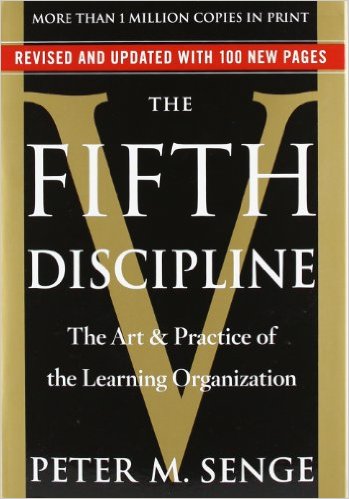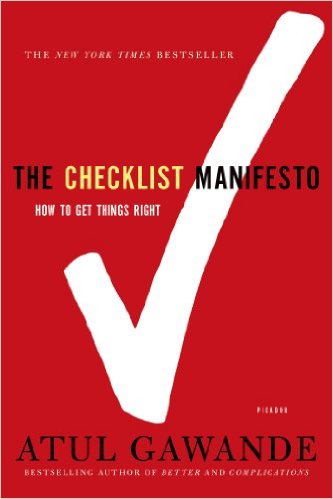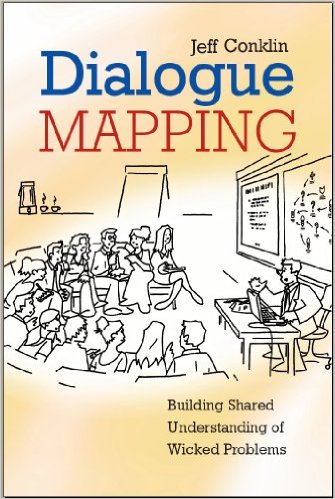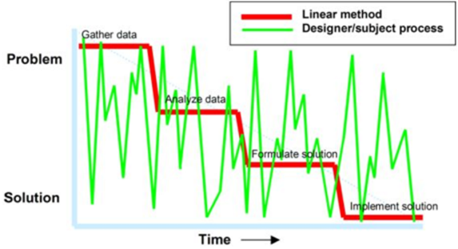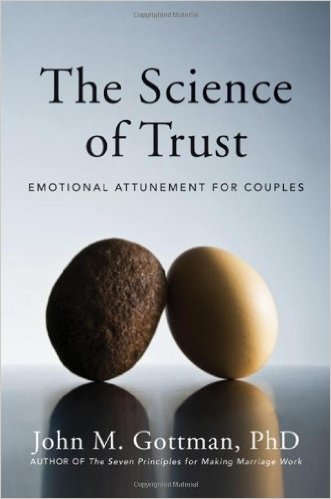Somewhere around the seventh grade I read a short story by Kurt Vonnegut titled “Harrison Burgeron“ from his book Welcome to the Monkey House. The story is a fictional account of a future world where everyone must have the same intelligence, physical ability, and beauty. The title character is blessed with many strengths and is burdened by governmental attempts to reduce his abilities to the norm. The story is a glimpse into what happens when making everyone fall to the least common denominator. Sometimes it feels like we’re all being held back to the lowest common denominator.
This memory came to me as I was rereading The Fifth Discipline: The Art and Practice of the Learning Organization. I had read it years and years ago and realized recently that I couldn’t remember much about the book. One benefit of the rereading was that it has been recently updated and revised with new content – content that makes the book relevant today.
Organizational Learning
If this book is about the fifth discipline, what are the other four? Well the five disciplines, according to the book, are:
- Personal Mastery
- Mental Models
- Shared Vision
- Team Learning
- Systems Thinking
The subtitle of the book – “The Art and Practice of the Learning Organization” – means that it’s also important to consider what a learning organization is. A learning organization is an organization that’s continuously growing, adapting, and changing as it learns more about itself, the environment, and the future. This is as opposed to an organization headed by one person who steers the ship and once they’re gone the company is ultimately headed for doom without it’s leader – as Jim Collins found out in his research and cataloged in his book Good to Great: Why Some Companies Make the Leap … and Others Don’t. A learning organization is one where the concepts have become so engrained that the leader becomes mostly irrelevant – that is, they’ve set the organization up for such great success that they aren’t needed any longer.
In truth, Singe didn’t deliver the goods in The Fifth Discipline as to how to create a learning organization, so I’ll cover that in a future blog post – for now, we’ll cover the five disciplines which are covered in the book. The disciplines start with our old friend, personal mastery.
Personal Mastery
A virtual prerequisite for organizational learning is the need for the people in the organization to have a commitment to personal mastery. In Singe’s view, personal mastery is about clarifying what’s important to us and ensuring that we see reality clearly. From my perspective, there are different components of personal mastery. There’s certainly the aspect of clarifying importance – however, I see this really as becoming more in touch with yourself and who you are at your core.
I sometimes say that it took me more than 30 years to become comfortable in my own skin. It took that long for me to really get to like the person I was and to have the confidence to stand out and be myself. In that is anaspect of self-confidence, but the statement is really much deeper than that. It was a semi-conscious decision to like myself. It’s a decision to integrate self-images which surfaced the things that I did well and self-images of where I’m weak. It was about accepting that I’m a good person – but far from perfect.
Clarifying what is important to us is both difficult and elusive. It’s difficult because we spend so much of our lives just getting by. We don’t think about what we truly want – we think about what we can have. “If you can’t be with the one you love honey, love the one you’re with” – as the song by Stephen Stills goes. We dream of winning the lottery or being promoted at work – but how does that get us what we want? If you ask most people, they’ll say that winning the lottery will allow them to do what they want to do. They won’t have to go to their job.
However, if you survey lottery winners, more often than not, in a few years they end up unhappier than when they won the lottery. Why? Because they quit their job and did their hobby. That’s not bad – except they stopped having fun with their hobby because they did too much of it. They quickly became bored with life and didn’t know what to do with their time to fulfill it. As The Me I Want to Be and How Children Succeed say, we need challenges to live.
Clarifying what is important is also elusive because what we want will change over time. Starting my career I wanted to create great technology solutions for people. I wanted to come up with innovative ways to solve problems. However, over the years I’ve come to realize that if you build a better mouse trap the world won’t beat a path to your door. That realization has led me to be more interested in how to help people see that they can do something to improve their condition. Said differently, I want to help people unlearn the learned helplessness – as I discussed in my reviews of The Paradox of Choice, and Who Am I? (The topic also appears in Boundaries and Beyond Boundaries).This means a lot more focus on how people work, how our brains work, and how groups of people interact. I still love using technology to solve problems. (See How This Developer Solves a Puzzle.) However, for years I’ve been shifting to solving the problem of getting users to use the solutions I create.
I mentioned in my review of God Loves You that knowing something and accepting it emotionally are two different things. You can integrate your image of yourself intellectually but still struggle to accept it emotionally. Through my divorce I got connected to a 12 step program. One of the things that I got to experience is how the program helps you realize that you do have things to work on – parts of who you are that need to become better. And, that just as you are not all good – neither are you all bad. Somehow you work on getting better – and being a better you – while accepting that you’re not a bad person.
One of the challenges of applying a program designed for addictions to people with “high bottoms” is that it’s often difficult to get to the point of sufficient trouble to really deeply explore how to become a better person. Said differently, the pain of changing has to be less than the pain of staying the same.If your life is mostly going well, there’s little incentive to look deeply to understand who you are – and change it. Addicts often have low bottoms. The loss of a marriage, an arrest, losing their worldly possessions – however, most non-addicts don’t have that level of pain in their lives.
Perhaps the greatest realization in a 12-step program is that you’re never recovered – you’re always recovering. You must make a conscious effort each day to be better than you were the day before. And as Brené Brown would say, that takes courage. (See Daring Greatly.) It takes courage to be vulnerable. Ultimately personal mastery is the journey to become a better person every day. The journey towards personal mastery is the reward. The reward shows up in how you see the world, how you interact and respond with it. Having a growth-oriented mindset (see Mindset) is a powerful mental model which can drive you forward.
Mental Models
When Gary Klein set out to talk to fire commanders about how they directed resources at a fire, he expected that he’d find a rational decision model in action. Highly educated experts with great experience would evaluate all of their options and chose the best choice. However, what he found, as he documents in Sources of Power, was far from that. What he found is that fire commanders couldn’t describe how they were making decisions – but they absolutely didn’t use evaluative approaches to determine which solution was the best one. They kept saying that the answer just came to them. It was intuition. However, intuition is hard to teach, so Klein didn’t give up. Over time he built an awareness that the fire commanders were working from a complex set of mental models – a set of beliefs about how fires behave and what their causes must look like.
Because of this, the fire commanders could run a simulation of the situation in their heads and ultimately decide whether a course of action would be successful or not. More often than not, their simulations were right. What they expected to happen did – and if something that they expected to happen didn’t, they would pull back, reevaluate the situation, and plan to attack the fire with a new perspective on the cause and how it should behave.
We all have a set of mental models that we use to interact with the world. Thinking, Fast and Slow says that we spend most of our time in a sub-conscious operational mode where our underlying beliefs will quietly guide our decisions without our conscious awareness. Think about your last drive. How many red lights did you encounter? Most of us couldn’t answer that questions because we’re not really consciously perceiving our world. We’re operating in “automatic” mode.
The Fifth Discipline talks about mental models as deeply ingrained assumptions that govern how we work. If we fundamentally believe that we’re not able to fulfill our desires, we’ll sabotage our success – especially when we get it. We may find that we espouse one set of beliefs, but our behaviors are different – we know that we want to believe something, but that we actually don’t. As Singe points out, if I believe that people are basically trustworthy, but never lend friends any money or things – then perhaps my true belief is different than that people are basically trustworthy.
You can shut down the hidden power of mental models in your world by making your mental models explicit and verifying that the mental models that you believe you have are the mental models that you really have. Mental models gain their power because they are unconscious and unclear. The more that you understand yourself – including the mental models that you’re operating with – the more effective you’ll become.
At a personal level, in order to flourish, you’ll need to trade in or trade up some of your mental models. If you believe that you can’t get what you want or that you’re not good enough – you’ll want to change those models. Many adults who grew up in poor homes expect that they’ll struggle with finances – and so they do. This is irrespective of the money that they make.
Professionally, if your mental model is that canal shipping is the best way to ship things and the train will never be practical, you might find yourself trapped in the past. In Indiana, the state defaulted on some debt for the completion of the Wabash and Erie Canal. As a result, the state has a prohibition on debt. One broken mental model about transportation changed a different mental model about whether it’s OK to carry debt – or not. That moment created a crystalizing event where the politicians of the day decided that they had a singular vision about whether they would ever default on a state debt again.
Shared Vision
Having a model of your own is a great start, but it’s not the end. You need to ensure that the others in the organization share the same models – or at least some of the same models. If you don’t, you’ll find that your energies are being wasted by misalignment.
Consider for the moment how different sources of light are useful. An oil lantern might be visible from a 1000 feet away. A more focused light source from a lighthouse can reach out 28 miles (~170K feet). Sure, there’s more light energy there – but more than that, the lighthouse uses a Fresnel lens which focuses the light along the horizon. It’s 40 times more intense at a given distance for the same power. An even more focused beam of light in the form of a laser is 900,000 times more efficient than a lantern. A laser can shine to the moon and back – or even cut metal. The more focused you can make things the more powerful they can be. It’s true of light and it’s true of organizations.
So how do you get to a shared vision? Well, there’s a technique that you may want to try. It’s the 5 Why’s. It’s interesting because it’s a way to try to get to the root of why people believe what they believe. It’s typically designed to explore the cause and effect relationships of problems, but it’s very useful in helping to clarify the stacks of assumptions, goals, and objectives in which people believe. The technique is simply asking why five times in a row.
For instance, someone says they want a new red sports car and you ask why. They say because they want to be able to ride around on a summer afternoon and you ask why. They say that they want to be cool and you ask why. They say that they want to feel like they’re a part of the in crowd and you ask why. They answer that they were never a part of the “in” crowd and they want to feel like they’re cool. Obviously the point isn’t that five is the magic number. It’s the 5 Why’s because it often takes much more questioning to get to the root of the issue than most people expect.
A common pitfall when trying to create a shared vision is the platitude. A platitude is a dull, flat, trite remark – particularly when uttered as if profound. Platitudes happen. When people get exhausted they naturally default to a platitude. You can identify a platitude because no person can reasonably disagree with it. However, disagreement can be a good thing. It focuses a conversation and allows people to gain alignment on what they believe; to gain a shared understanding. Alfred Sloan – former CEO of General Motors – said “Gentlemen, I take it we are all in complete agreement on the decision here… Then I propose we postpone further discussion of this matter until our next meeting to give ourselves time to develop disagreement and perhaps gain some understanding of what this decision is all about.” It’s possible to get locked in a conversation and not make progress and equally possible to grind away at topics until everyone is aligned.
If you find that when you’re tired of discussing things you’re prone to creating a platitude to end the disagreement and discussion,that’s not a problem. You simply need to come back, revisit, and replace the platitude later.
Team Learning
There’s a scene at the end of “War Games” (Amazon, IMDB) where they’re trying to get the computer to learn that there are some games that have no winner – including war games, thus the title of the movie. You may have heard that an eye for an eye leaves everyone blind. However, there are at least a few “teams” that have somehow missed this basic understanding of how things should be done. They continue to beat each other with their words, actions, and inactions. In short, they’ve failed to learn.
In 1956, Benjamin Bloom and his colleagues got together to discuss educational objectives. The outcome of those meetings is largely referred to as Bloom’s Taxonomy of hierarchical educational objectives. This is perhaps the most commonly used model for assessing educational materials and approaches. What is lesser known is that the model was a set of three models that were planned including cognitive, psychomotor (movement), and affective (feeling emotion.) Only the cognitive model has been widely used. That model moves from recognition (I can find the right answer), recall (I know the right answer), up through understanding (I know what the answer means) and to analysis, synthesis, and evaluation (I know what to do with the answers). Certainly there are educational objectives for teams and a need for contributors to be able to analyze what the information means, however, it’s more than that.
The affective domain may be more applicable to team learning than the cognitive domain. As it turns out, having teams that can bond with each other, who can work together, and who have developed emotional intelligence may be more important than having the most charismatic leader. Jim Collins, in Good to Great, speaks about the Stockdale Paradox – a leader that has unwavering faith that you will prevail in the end and the discipline to confront current reality. That sounds a lot like someone who has learned Emotional Intelligence. On the one hand, they’re committed to the results and on the other hand they’re not denying reality. It could be that they’ve learned the lessons from Bonds that Make Us Free, Leadership and Self Deception, and the Anatomy of Peace about the proverbial boxes that we get ourselves into and that distort reality.
Maybe it’s that they’ve completed the short course on Heroic Leadership from the Jesuits. Maybe the idea of driving a desire for self-awareness, ingenuity, love, and heroism have been driven into the character of the organization, like Loyola drove the principles into the Jesuits. Perhaps they studied Buddhism and learned Emotional Awareness. No matter where it came from, great leaders have had the courage to take a position and the vulnerability to accept that their position may not be right. Creating a team that has the perseverance (what How Children Succeed would call grit) is an essential first step to the ability to learn. The perseverance we’re discussing here comes from being able to be open and honest with other people.
Emotional Intelligence in Parts
Emotional intelligence, as I discussed in my review, is composed of self-awareness, self-management, social awareness, and relationship management. While not directly linear, the skills do tend to build on one another because it’s hard to manage yourself if you don’t know what you’re feeling and hard to manage relationships without a way to know how other people feel.
However, as the section on personal mastery above suggested, it’s also true that you need to be able to know how to be self-aware and self-managing before you can interact on a team – before you can be in a relationship with others. That isn’t to say that everyone who is in a relationship is a master of self-awareness and self-management. However, it does mean that people who are relationship masters have some level of self-awareness and self-mastery.
As it turns out, the real opportunities for team learning are how the team manages the relationships in the team – it’s not about the cognitive learning that they’ve done – it’s about the affective learning that has been done. It’s about the relationships that have been built and how they’re managed.
Learning from Love Relationships
The Fifth Discipline largely left the clear understanding of team learning as an exercise for the reader. It seems like a good idea to get input from a relationship expert to learn more about the relationships that drive team interaction. In writing this review, I was stuck trying to describe how to measure the effectiveness of a team except through the lagging indicator of team performance. So I put this book review aside and worked on other things, one of those is my reading and review of John Gottman’s book The Science of Trust. In Gottman’s book, he describes the four horsemen of the [relationship] apocalypse. Gottman’s research is widely known because within a few minutes of heated discussion, he can predict which couples will stay together and which will divorce with greater than 90% accuracy. His research identified characteristics that, if found in any significant measure, can spell doom for a relationship.
While a business team relationship is quite different from a romantic one, the underlying dynamics of both types of relationships are similar. Both relationships are built on trust. Because of foundational similarities, Gottman’s guidance for a couple may be strangely applicable to building teams. The factors that drive couples to have good relationships are the same factors that drive teams to work well together. Similarly the measures of sickness in a relationship are the same, whether it’s a business team relationship or a romantic one.
Gottman’s four horsemen – when found – indicate that the team isn’t learning how to be a team. The group of people may be called a team – but they’re not a team. The four horsemen are:
- Criticism – That is an unnecessary and uncaring attack on the person – not an open dialog of the idea. The key point is the criticism of the person and not the idea. The problem is being attributed to the person, instead of a disagreement or misunderstanding. (See fundamental attribution error in The Advantage and Switch.)
- Defensiveness – Defending one’s own position instead of being open to opportunities for growth and support. Often this shows up as an attack being met with a counter attack. The words are often “Yes, but…” Sometimes this shows up as a victim stance (See Beyond Boundaries and Daring Greatly for more on victimhood.)
- Contempt – Belief that someone is above or beyond the rest of the team. This can be moral superiority or simply technical supremacy. Contempt is exceedingly corrosive to trust and even a small amount of contempt can represent a real problem in a team. In couples, it was the factor that both indicated happiness and the prognosis for divorce.
- Stonewalling – Withdrawing from the interaction so that you don’t have to become invested in the result. This shows up as disengagement and effectively nullifies any positive effect that a team member might offer – while keeping all of the negative effects.
In Gottman’s research, he used a coding system to indicate when important markers were reached in a conversation. Actually evaluating the health of a team may require a trained observer – however, even a casual observer can identify problems when they know what they’re looking for. With the challenge of measuring a team based on these criteria, most folks fall back on the way they’ve always measured teams which is sometimes effective – and sometimes not.
Measuring Team Learning
Most of the time folks seek to measure team effectiveness on “performance.” Conceptually this makes sense. Ultimately the goal of any organization is to perform better. Performance may be measured in profit – as it often is for publically traded companies – or impact, as it tends to be with non-profit institutions. Whatever you measure, the organization should make a good foundational measurement for the teams in the organization. However, there’s a set of hidden problems with this approach to measuring team effectiveness.
One problem with this approach is that “performance” is a lagging indicator. That is to say you don’t know how good the team is until later. You don’t know when you put the team together – or even before the delivery of “performance” how the team is doing. If you can’t measure them early, you can’t make changes to improve the end performance, until later.
The second problem with the “performance” based approach is that it leaves open the definition of what performance is. Let’s take, for instance, the idea of creating a team to develop leads for the sales team. Their goal is to cull through information obtained at trade shows and turn over the promising leads to the sales team. In this case, what would the “performance” number be? The number of calls made? Perhaps it’s the number of emails sent? These are activity-based metrics that may – or may not – have any relationship to the profitability of the organization.
Closer performance metrics might be the number of qualified leads turned over to the sales team. However, as the noted manufacturing consultant W. Edwards Deming said, “You get what you measure.” If the measurement is the number of qualified leads turned over to the sales team, the meaning of “qualified” will likely be a pretty low bar. Of course, if you define performance as the amount of the profit from the leads then you’ll be involving the evaluation of a separate team – sales – and you’ll be waiting for a long time, particularly if you have a long sales cycle.
The difficulties in measuring success are the reason that trying to find leading or coincident measures of team learning are so important – and why the use of relationship evaluation techniques are essential to measuring the effectiveness of team learning. This leads us to attempting to find a better place to identify the problems and opportunities in the system – and that requires systems thinking.
Systems Thinking
We live in a complicated world where things change in ways that seem strange and complex. The collapse of the canal transportation industry seems obvious in hindsight, however, at the time it was difficult to consider how the primary transportation vehicle of the day would become obsolete. It’s a view beyond the neat cause and effect relationships that scientists like to play with that occupy the minds of people who are thinking in systems. Instead of cause and effect, they see forces at play – both known and unknown. They look for driving forces and how those driving forces might be misdirected and the impact of the misdirection.
Singe talks about three keys to systems thinking. They are:
- The law of unintended consequences
- Reinforcing loops
- Balancing loops
Before exploring these three keys, there’s a concept that is important to understanding them. That is that systems have delays in them. Reactions aren’t immediate and never changing. Reactions are frequently delayed and it’s sometimes those delays that cause the greatest issues.
Consider turning on a shower and getting the right temperature. You turn the shower on and set it to all hot water because the water in the hot pipes is actually cold. Gradually you make adjustments to the mixture of hot and cold water. The problem is that your changes in the water mixture aren’t realized through the showerhead immediately. You have to wait on the changes to take effect or you’ll be managing oscillations of hot and cold water as you’re constantly trying to adjust too late. With that understanding, let’s look at the three keys of systems thinking.
The Law of Unintended Consequences
Most people tend to think in one-dimensional cause and effect type thinking. That is they think that if they make a change it will have a single specific effect. However, one of the truths of most things in life is that every change has both intended and unintended effects. I learned about unintended consequences through Diffusion of Innovation. Even with the best of intentions, if you don’t really know the entirety of the system – and you rarely can when people are involved – you may cause unintended consequences.
As Horst Rittle defined a “Wicked Problem“, some problems cannot be solved in a traditional sense. The information you have may be incomplete, may be contradictory, or the requirements may be changing in ways that are difficult to keep up with. Many of the problems that we deal with today are wicked problems and our lack of understanding of them, as well as their dynamic nature, make it difficult (or impossible) to forsee all of the unintended consequences.
Reinforcing Loops
John Maxwell called it “The Big Mo” – short for momentum – in The 21 Irrefutable Laws of Leadership. It’s what happens when continued effort reinforces the outcome over time. Malcom Gladwell talked about the results of momentum in Outliers. He talked about how the greats became that way through intentional practice for 10,000 hours or more. Howard Gardner said it takes ten years or more of practice to become an expert in Extraordinary Minds. Gary Klein said that experts think of problems differently in Sources of Power. In Efficiency in Learning and Lost Knowledge we learned about the impact of mental models on learning and how experts simply think about problems differently. I firmly believe that the more time that you spend deliberately doing something the more momentum that you build in that thing – and as a result, the easier it gets.
Momentum is easy to see in our financial lives. If you put money into a guaranteed investment it will grow over time. If the investment returns – on average – a 12% return, it will take about 6 years for the amount to double. That’s because of the power of compounding interest – that is the momentum of the earned interest adding to the momentum of the investment.
In the world of writing, you can see old journalists and authors crank out material quickly. Their work in creating content has become so ingrained in them that it becomes faster to write the next story or novel, which in turn reinforces their ability to do the one after that. Many of the systems we encounter have reinforcing loops.
However, reinforcing loops in the real world often work inside a larger system where there are not only reinforcing loops – but balancing loops as well.
Balancing Loops
Reinforcing loops are generally considered to be good things. However, they are not always that. Sometimes debt can become a reinforcing loop that makes it harder and harder to dig out of debt and get into a better financial situation. Whether positive or negative, reinforcing loops are generally easy to see in action. The alternative forces in systems are balancing loops which are more difficult to see.
The Tacoma Narrows Bridge, nicknamed “Galloping Gerdie”, was so named because of its fluctuations. Ultimately the bridge was destroyed by aerodynamic forces. Aerodynamic forces had never been considered during the development of bridges, because aerodynamic forces were so insignificant they weren’t a consideration – until the building technologies advanced into stronger and substantially lighter materials. Suddenly, a new balancing loop appeared for engineers trying to build bridges. They needed to maintain certain mass and aerodynamic qualities to prevent the balancing loop from destroying the usefulness of the bridge. No longer could bridges continue to get lighter and use less material.
Consider a successful consulting practice where the business is good. The owner spends more time working in the business – taking care of clients – and less time building the business through sales and recruiting. And so the success reduces the ability of owner to work on building the business and thus the business grows at a slower rate. The limiting factor to long term growth is short term revenue.
Five Disciplines in One
Despite the fact that Singe didn’t deliver to us how to create a learning organization, the coverage of the five disciplines is impressive. As you’ve seen in this review, he pulls together ideas from many other authors an luminaries. The map that he lays out inside each discipline is sound and worthy of following.
The Fifth Discipline isn’t the kind of book you pickup on a long trip, read, and never consider again. It’s the kind of book that you steep yourself in for weeks or months trying to absorb what you’ve read. In fact, the lag between reading the book and writing the review is one of the longest that I’ve had as I sought to connect the pieces to other thoughts, understand what was written, and figure out what I wanted to do with it.
If you’re ready to start the journey to becoming a better person, to creating an environment for organizational learning, and you’re ready to change your organization for the better, pick up The Fifth Discipline.


